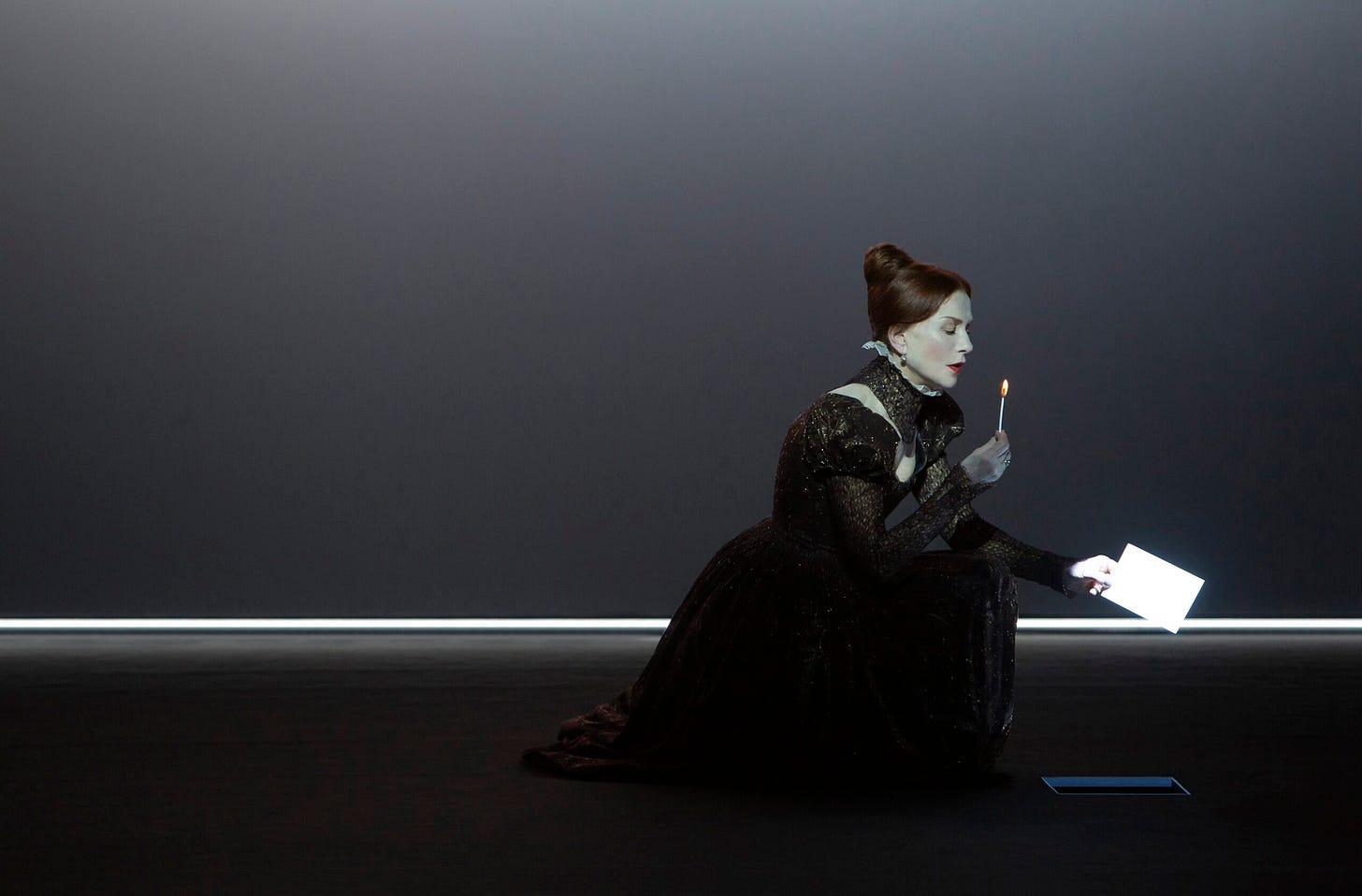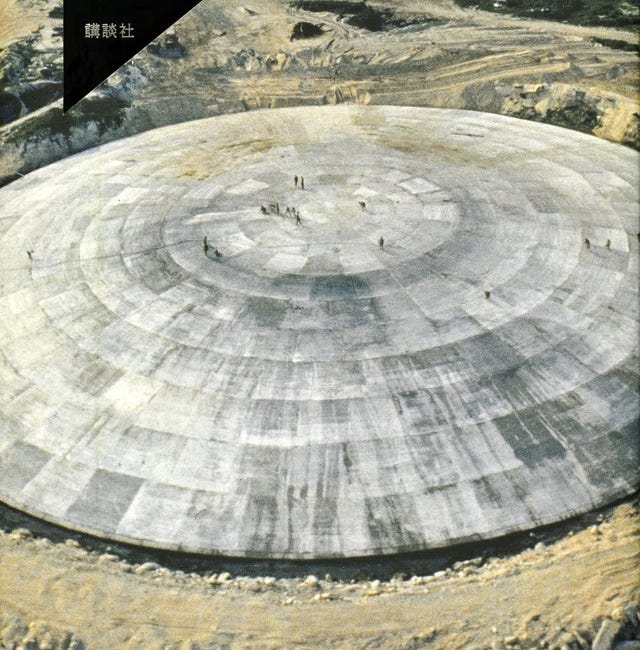Culture, Digested: A Politician Walks into a Theater
Isabelle Huppert plays Mary Queen of Scots
I noticed the jacket first. I like to sit on the aisle when I go to the theater because I like to see what everyone is wearing. There’s no real shared idea for why we go to the theater these days – our own edification? a noble intention to “save the arts”? to be in close proximity to the Hollywood stars who are increasingly dragged onto the stage whether they can actually act in live theater or not just to sell tickets? – and this confusion is often expressed in people’s outfits. But even at the matinee, the audience is primarily older women and they tend to get out some really good outfits and I enjoy watching them.
But I looked up and saw this woman in a long jacket standing next to me, and I thought, ugh. It was embroidered in that vaguely “ethnic” pattern that looks to communicate, I am worldly in a very specific way, and that way is that I think all the world’s poor people are one indistinguishable mass, but I love/pity them and I like to buy their handicrafts. If you donate $10,000 to NPR’s world music programming, you would probably get this jacket in the mail.
At any rate, I saw the jacket and snorted to myself in my awful snobby way and then the woman wearing the jacket turned her head a little and I gasped audibly. It was Hillary Clinton. She took her seat just in front of me, her security team creating a barrier between us.
We were both at the NYU Skirball Center to see Mary Said What She Said, Darryl Pickney’s script of the internal monologue of Mary Queen of Scots as she awaits her execution. Isabelle Huppert plays Mary, or more accurately she plays a vortex in the shape of Mary, as her words spin around and get trapped, repeating words, phrases, and certain images. But even as everything tilts towards mania, Huppert retains precision and control. It’s a remarkable performance, as she is occupying and filling a stage alone for 90 minutes.
Pickney’s writing does little to orient you within Mary’s biography. There are desperate references to husbands, children, enemies, servants, ladies in waiting, but they all blur past. One of the phrases she repeats as the thoughts run through her head is that in her fight to regain and retain her throne she has gotten so many people killed. “What glory.” “What glory” is repeated in anger, exhaustion, defiance. As a viewer you kind of have to chase Mary, trying to make these assorted thoughts and fixations cohere – but also it doesn’t really matter what kind of person Mary was. Mary was a queen, not a person.
Isabelle Huppert wears the traditional royal dress, the kind of thing a woman is not meant to move in. It restricts movement with a corset, a tightly bound bodice, and a high neck ruff. This communicates its wearer’s status. This is not a woman who labors, this is a woman for whom others labor. This is a woman for whom others die. But Huppert does move – as directed by Robert Wilson, she stomps, she floats, she does a demented little dance. And every time she raised her arms in anger above her head you see the dress resist. Huppert is in a war against that dress, and you feel it as she moves.
Sitting behind Hillary Clinton, though, I couldn’t help but think about her foray into theater production: the dreary little musical Suffs. It wasn’t bad, and it didn’t do a terrible job at illuminating the lives of the women who fought and died for the right to vote. But it was patronizing. It was a political project more than a theatrical experience, and it had many of the same problems as the 2015 film Suffragette: in the creators’ eagerness to make the audience think these women important they failed to make them interesting.
The New York Times asked this week, five years too late, “Why Does Every Play Seem Political Now?” Not to invite the return of “all art is political” discourse, but the essay fails to understand its own question. All art can be read as ideological if you are an ideologue, which most of our critics these days are. But also theater, like just about every other artform, doesn’t trust its own audience anymore and so wants to be extremely clear in its intentions and designs. No one in Suffs says directly to the audience, “And that is why you should have voted for a woman president!” but they might as well have. Even if they had, though, it would not have been a confrontation but simply a reinforcement of what the makers of the play can reasonably expect its audience already to believe.
Mary Said What She Said felt more like being trapped in a thornbush during a windstorm. The only political message was that people who wield power will, every time, be surprised when power is wielded against them.
Recommended:
Filthy Dreams looks at the New Yorker’s merch, specifically the “Future Critic” t-shirt for kids.
Everything (and more!) that you might have wanted to know about the Zizian cult.
In case you missed it, Graham Dethmers wrote about the work of Japanese novelist Tsushima Yuko for us last week:
People Live Here: Wildcat Dome and the Late Work of Tsushima Yuko
·Locals call it “The Tomb,” but it is more generally known as the Runit Dome, named for its island home, Runit Island. Made of eighteen-inch thick concrete, the structure itself was built over a crate…







I remember interviewing for a nonprofit job and the interviewer (some sort of deputy boss) was wearing exactly that type of jacket. Didn't get the job, possibly because the jacket provoked some latent hostility and envy that she could do something so publicly good but also afford generically "ethnic" expensive clothing. A presumably good soul would be happy to do be employed doing good works while wearing thrift or H&M, but my soul isn't good enough at all...
"... theater, like just about every other artform, doesn’t trust its own audience anymore and so wants to be extremely clear in its intentions and designs" - I would add also (especially?) in the "re-imagining" of the presentation of older works - such that I've just lost interest in following what is new at this museum or that theatre, because it isn't actually very new. I'd go see this, though.